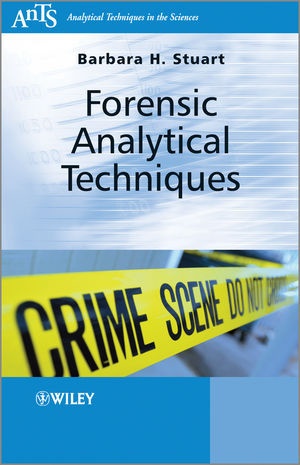Read more
Informationen zum Autor Barbara Stuart (BSc(Hons), MSc(Syd), PhD(Lond), DIC, MRSC, MRACI, Cchem) After graduating with a BSc degree from the University of Sydney in Australia, Barbara Stuart worked as a tutor at this university. She also carried out research in the field of biophysical chemistry in the Department of Physical Chemistry and graduated with a MSc in 1990. The author moved to the UK to carry out doctoral studies in polymer engineering within the Department of Chemical Engineering and Chemical Technology at Imperial College (University of London). After obtaining her PhD in 1993, she took up a position as Lecturer in Physical Chemistry at the University of Greenwich in London. Barbara joined the staff at the University of Technology, Sydney, Australia in 1995, where she is currently a Senior Lecturer in the Department of Chemistry, Materials and Forensic Science. She is presently conducting research in the fields of polymer spectroscopy, materials conservation and forensic science. Barbara is the author of four books published by Wiley, "Modern Infrared Spectroscopy", "Biological Applications of Infrared Spectroscopy", "Polymer Analysis" and "Infrared Spectroscopy: Fundamentals and Applications" in the current ANTS series of texts and "Analytical Techniques in Materials Conservation". Klappentext The book will be an open learning / distance learning text in the Analytical Techniques for the Sciences (AnTS) covering analytical techniques used in forensic science. No prior knowledge of the analytical techniques will be required by the reader.An introductory chapter will provide an overview of the science of the materials used as forensic evidence. Each of the following chapters will describe the techniques used in forensic analysis. The theory, instrumentation and sampling techniques will be explained and examples of the application of each technique to particular forensic samples will be provided. The reader will be able to assess their understanding with the use of regular self assessment questions and discussion questions throughout the book. The user of the book will be able to apply their understanding to the application of specific techniques to particular analyses encountered in their professional life. Zusammenfassung The book offers an open learning/distance learning text covering analytical techniques used in forensic science. After an introduction, chapters describe specific techniques including background theory, instrumentation, and sampling techniques, along with examples of their forensic samples. Inhaltsverzeichnis Series Preface xiii Preface xv About the Author xvii Acronyms, Abbreviations and Symbols xix 1 The Chemistry of Forensic Evidence 1 1.1 Introduction 1 1.2 Evidence Types 2 1.2.1 Polymers 2 1.2.2 Fibres 6 1.2.3 Paint 7 1.2.4 Documents 9 1.2.5 Glass 10 1.2.6 Soil 11 1.2.7 Explosives 12 1.2.8 Firearms 14 1.2.9 Arson 14 1.2.10 Body Fluids 16 1.2.11 Drugs and Toxicology 16 1.2.12 Fingerprints 21 1.3 Introduction to Data Analysis 23 1.4 Summary 24 2 Preliminary Tests 27 2.1 Introduction 27 2.2 Chemical Tests 27 2.2.1 Methods 28 2.2.2 Drugs and Toxicology 28 2.2.3 Body Fluids 29 2.2.4 Gunshot Residue 30 2.2.5 Explosives 31 2.2.6 Paint 31 2.2.7 Documents 32 2.3 Density 32 2.3.1 Methods 32 2.3.2 Glass 33 2.3.3 Soil 33 2.3.4 Polymers 34 2.4 Light Examination 35 2.4.1 Methods 35 2.4.2 Fingerprints 36 2.4.3 Body fluids 38 2.4.4 Documents 38 2.5 Summary 39 3 Microscopic Techniques 41 3.1 Introduction 41 3.2 Optical Microscopy 42 3.2.1 Methods 42 3.2.2 Interpretation 44 3.2.3 Fibres 45 3.2.4 Paint 48...
List of contents
Series Preface xiii
Preface xv
About the Author xvii
Acronyms, Abbreviations and Symbols xix
1 The Chemistry of Forensic Evidence 1
1.1 Introduction 1
1.2 Evidence Types 2
1.2.1 Polymers 2
1.2.2 Fibres 6
1.2.3 Paint 7
1.2.4 Documents 9
1.2.5 Glass 10
1.2.6 Soil 11
1.2.7 Explosives 12
1.2.8 Firearms 14
1.2.9 Arson 14
1.2.10 Body Fluids 16
1.2.11 Drugs and Toxicology 16
1.2.12 Fingerprints 21
1.3 Introduction to Data Analysis 23
1.4 Summary 24
2 Preliminary Tests 27
2.1 Introduction 27
2.2 Chemical Tests 27
2.2.1 Methods 28
2.2.2 Drugs and Toxicology 28
2.2.3 Body Fluids 29
2.2.4 Gunshot Residue 30
2.2.5 Explosives 31
2.2.6 Paint 31
2.2.7 Documents 32
2.3 Density 32
2.3.1 Methods 32
2.3.2 Glass 33
2.3.3 Soil 33
2.3.4 Polymers 34
2.4 Light Examination 35
2.4.1 Methods 35
2.4.2 Fingerprints 36
2.4.3 Body fluids 38
2.4.4 Documents 38
2.5 Summary 39
3 Microscopic Techniques 41
3.1 Introduction 41
3.2 Optical Microscopy 42
3.2.1 Methods 42
3.2.2 Interpretation 44
3.2.3 Fibres 45
3.2.4 Paint 48
3.2.5 Drugs 49
3.2.6 Glass 49
3.2.7 Soil 50
3.2.8 Documents 51
3.2.9 Firearms 51
3.3 Transmission Electron Microscopy 51
3.3.1 Method 52
3.3.2 Interpretation 53
3.3.3 Paint 53
3.4 Scanning Electron Microscopy 54
3.4.1 Methods 54
3.4.2 Interpretation 55
3.4.3 Gunshot Residue 56
3.4.4 Paint 57
3.4.5 Fibres 58
3.4.6 Documents 58
3.4.7 Glass 59
3.5 Atomic Force Microscopy 59
3.5.1 Methods 59
3.5.2 Interpretation 60
3.5.3 Documents 60
3.6 X-Ray Diffraction 60
3.6.1 Methods 62
3.6.2 Interpretation 63
3.6.3 Explosives 63
3.6.4 Paint 63
3.6.5 Drugs 64
3.6.6 Documents 65
3.6.7 Soil 65
3.7 Summary 66
4 Molecular Spectroscopy 69
4.1 Introduction 70
4.2 Infrared Spectroscopy 70
4.2.1 Methods 70
4.2.2 Interpretation 73
4.2.3 Paint 74
4.2.4 Fibres 75
4.2.5 Polymers 84
4.2.6 Documents 86
4.2.7 Explosives 89
4.2.8 Drugs 89
4.3 Raman Spectroscopy 89
4.3.1 Methods 90
4.3.2 Interpretation 91
4.3.3 Drugs 91
4.3.4 Paint 93
4.3.5 Fibres 94
4.3.6 Documents 94
4.3.7 Explosives 94
4.4 Ultraviolet-visible Spectroscopy 95
4.4.1 Methods 95
4.4.2 Interpretation 97
4.4.3 Fibres 97
4.4.4 Paint 98
4.4.5 Documents 99
4.4.6 Drugs 99
4.4.7 Toxicology 101
4.5 Fluorescence Spectroscopy 101
4.5.1 Methods 101
4.5.2 Interpretation 102
4.5.3 Body Fluids 102
4.5.4 Toxicology 103
4.5.5 Fibres 104
4.6 Nuclear Magnetic Resonance Spectroscopy 104
4.6.1 Methods 104
4.6.2 Interpretation 105
4.6.3 Drugs 107
4.6.4 Explosives 108
4.7 Summary 109
5 Elemental Analysis 113

